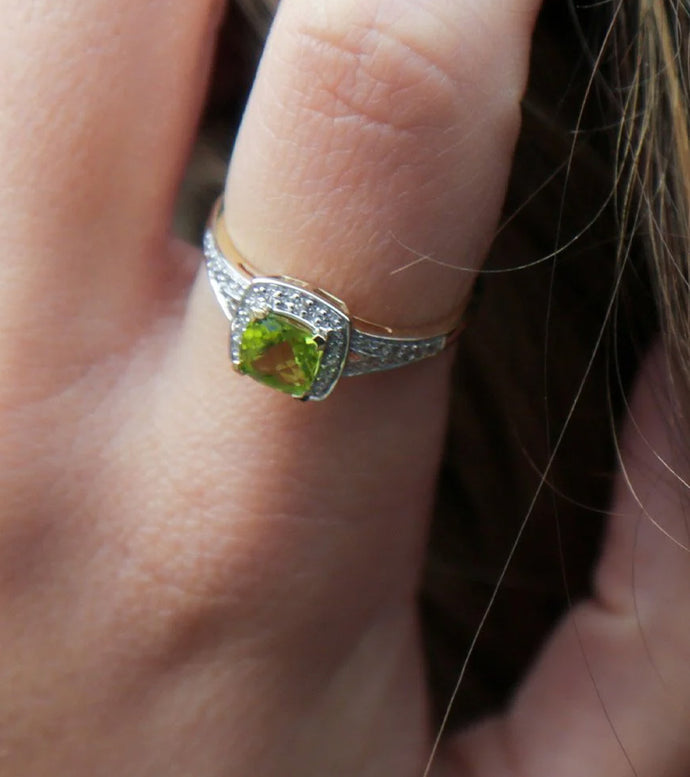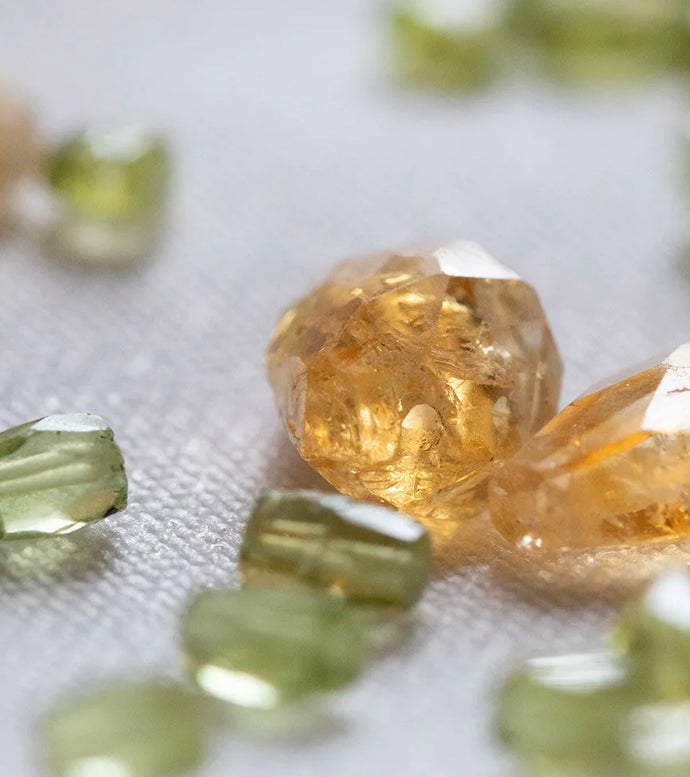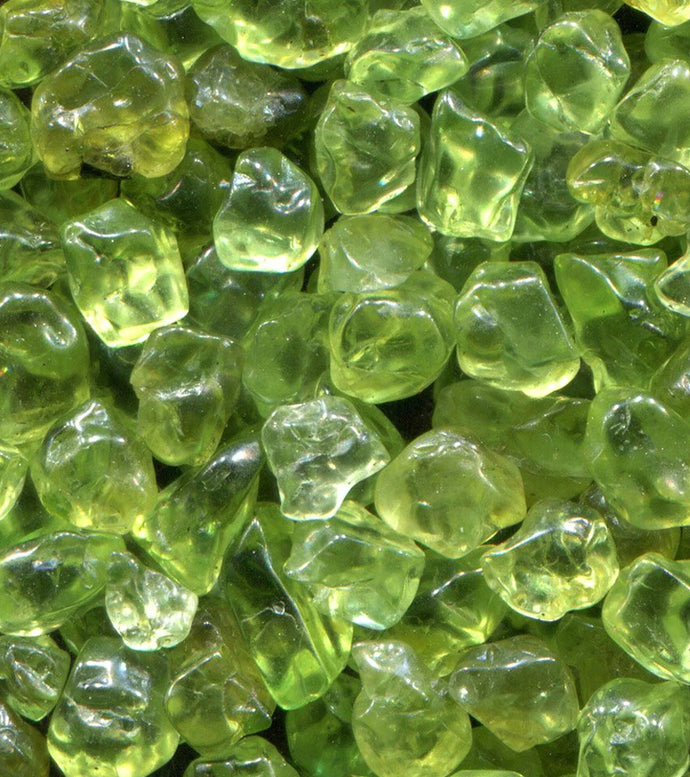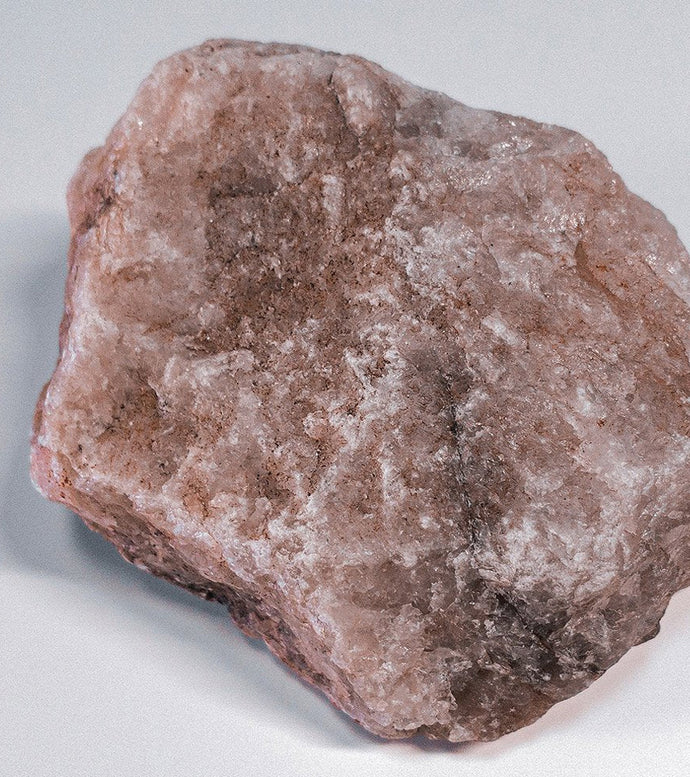August Birthstone
Like the previous month, those who are born in August are also lucky enough to have two birthstones. The two August birthstones are Peridot and carnelian. A yellowish-green colour, peridot stones are the more popular gemstone of the two and are often complemented by yellow gold jewellery.
Carnelian stones, on the other hand, are a fiery amber tone. These birthstones are smooth and prominently feature fine lines which some would say is reminiscent of the surface of the planet Venus.
From their meanings to their origins, read on to learn all about the August birthstones and to check out some eye-catching Peridot jewellery.
OVERVIEW OF THE AUGUST BIRTHSTONE:
- Peridot components & meanings
- The history of peridot
- Where is Peridot found?
- Our favourite peridot jewellery
- Carnelian components & meanings
- The history of carnelian
- Where is carnelian found?

PERIDOT COMPONENTS AND MEANINGS
Greener than the vines that run down trees, this August birthstone is often seen as the lesser of the gemstones and is often overlooked because of this. But let us assure you that the Peridot is anything but ordinary.
A gemstone of the mineral olivine, the chemical composition of peridot includes iron-which gives the stone its striking olive colour and magnesium. Peridot crystals are formed from magma deep within the earth's surface in what is known as a mantle. The stones are then brought to the surface by volcanic and tectonic plates. The vibrancy of the green is dependent on how much iron is contained within the stone.
Peridot stones have existed for many centuries and have therefore had many different meanings attributed to them. Symbolising light, strength and passion, the peridot was once thought to be found in volcanic ashes as it was the tears of the volcano goddess, Pele. One of only two gemstones to be born out of the fire and brought to light, Peridot stones also symbolises warmth. When set with gold, Peridots were also said to protect the wearer from nightmares and night terrors. It was for this reason and because it was said to protect the wearer from the evil that the Ancient Egyptians used to refer to this stone as the gem of the sun.
Peridot stones also have a strong association with Cosmos and the universe, this has led many people to believe that the stones harbour magical and celestial properties. The magic is believed to possess is said to bring healing, prosperity and lifelong happiness.

THE HISTORY OF PERIDOT
With origins dating back as far as the second millennium BC, the Peridot was once mined by the Ancient Egyptians on a snake-infested island on the Red Sea known as St John's Island. The Egyptians valued the stone so much that they even kept the location of the smoke-shrouded volcanos a closely guarded secret. Many Egyptian priests at the time also believed that these mystical stones harboured the power of nature and would use Peridot encrusted goblets to converse with their nature gods. The stones were also used by the Ancient Egyptians as carved talismans. Some historians even believe that Cleopatra's famed emerald collection was peridot. But the peridot stone's association with emerald wouldn't stop there, in Ancient Rome the stone was even dubbed the evening emerald'.
The world's fascination with these enchanting green stones would continue throughout Medieval times where a whopping 200-carat's worth of peridot was discovered embedded into a solid gold shrine within Germany's Cologne Cathedral. These stones were also believed to be emeralds at one stage. In the early 1500s, German occult leader Heinrich Cornelius believed that if you held peridot up the sun a golden star would appear that would heal you from any respiratory problems. It was because of this that Apothecary shops kept the gemstone in powdered form to help with ailments such as insomnia, bleeding and madness. Some even used the stone to help aid childbirth and improve memory.
The stone has seen somewhat of a resurgence since the 1990s when new deposits of the stone were discovered in Pakistan. Referred to as Kashmir Peridot', these were some of the finest gemstones ever discovered with some even measuring up to 100 carats.

WHERE IS PERIDOT FOUND?
A majority of today's peridot stones are sourced from Pakistan, the United States, Hawaii, Myanmar and the Himalayas. The world's biggest supplier of the stone is the dry, desert-like Arizona. There are four major peridot mines in the American state, they include Peridot Mesa in Gila County, Littlefield in Mohave County, Buell Park in Apache Country as well as Williams in Coconino County. At these mines, many locals and tourists try their luck at finding small deposits of this luscious green gemstone.
The largest peridot stone was found right where its human origins began, on Saint John's Island in Egypt. Weighting around 311 carats, this monstrous green stone which has a dark green-yellow tinge to it is now on display at the Smithsonian Museum in New York City.

OUR FAVOURITE PERIDOT JEWELLERY
Forget walking like an Egyptian, try dressing like one instead with our range of peridot jewellery. From peridot earrings to peridot pendants, peridot necklaces and peridot rings, check out some of our favourite picks below!
Shop Peridot

CARNELIAN PHYSICAL COMPONENTS AND MEANINGS
Flying almost under the radar due to its lack of notoriety, this semi-precious orangey-red stone is predominantly seen on vintage-style gold jewellery in the form of statement drop earrings, pendants and antique rings.
Considered to be a Chalcedony and a type of microcrystalline quartz, carnelian stones are formed from the intergrowth of two silica minerals with different crystal structures, usually quartz and morganite. With a dull, waxy-like lustre, the reddish-brown tints in the stone are due to one of the stone's featured minerals, iron oxide. Many of the stones are dyed to gain their colour vibrancy and variation.
Carnelian stones have adopted many meanings throughout their lifetime. Some of the elements that carnelian is thought to symbolise include emotional healing, individuality, sociability, memory, creativity, harmony, happiness, self-esteem, rebirth, reincarnation and even past lives. Seen as a stabilising stone, some also believe that carnelian helps restore vitality, provide motivation and helps stimulate creativity. The stone is also thought to help combat anger and negative emotions while also helping to improve a person's clarity and analytical skills.
Considered to be an ultra-healing stone, some people have utilised carnelian because they believe it will help treat lower back problems, arthritis, neuralgia and depression, while also improving fertility, regulating kidneys, accelerating bone healing as well as ensuring good blood supply to vital organs and tissues.

THE HISTORY OF THE CARNELIAN
With a history that dates back some 4500 years, carnelian stones have long been lauded by ancient communities and civilisations. Often appearing in antique jewellery, the Ancient Egyptians and Sumerians fashioned the stone into body ornaments while the Ancient Romans and Greeks would adorn the stone in stylish gold signet rings. In 5,500 BC, Bulgarian tribes would wear the stones in long, red bead necklaces. Evidence discovered at the ancient burial site, Varna Necropolis even suggests that not only did the tribes wear this stone but they also faceted them, with each stone containing around 16 facets.
In the Middle Ages, alchemists used carnelian to boil other quartz-like stones as they believed it would help activate their energies. During the Renaissance period, carnelian was engraved with an image of a warrior or a sword and was placed into homes to protect it from storms and other natural disasters. The gem was also carried around by people to protect them from ailments such as nosebleeds, skin diseases, blood diseases and insanity. They also kept it near as they slept to prevent nightmares and night terrors. Napoleon, the Emperor of France was known to sport a good luck charm that featured the stone, while German writer and scientist Wolfgang von Goethe also wore carnelian jewellery-believing it would bring luck and offer protection from evil.
WHERE IS CARNELIAN FOUND?
Deposits of the carnelian stone are predominantly found in Russia (Siberia), Germany, the United States, Uruguay, Brazil, India and Indonesia. The world's biggest exporter of carnelian is India, where a majority of these mighty red-orange stones are found.







































